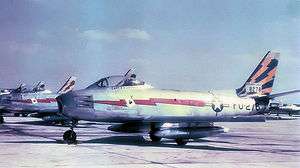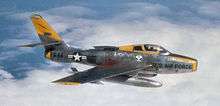RAF Shepherds Grove
RAF Shepherds Grove | |||||||||||
|---|---|---|---|---|---|---|---|---|---|---|---|
| Near Bury St Edmunds, Suffolk, in England | |||||||||||
 RAF Shepherds Grove Shown within Suffolk | |||||||||||
| Coordinates | 52°18′55″N 000°55′13″E / 52.31528°N 0.92028°ECoordinates: 52°18′55″N 000°55′13″E / 52.31528°N 0.92028°E | ||||||||||
| Type | Royal Air Force station | ||||||||||
| Site information | |||||||||||
| Owner | Ministry of Defence | ||||||||||
| Operator |
Royal Air Force United States Air Force | ||||||||||
| Site history | |||||||||||
| Built | 1943 | ||||||||||
| In use | 1944-1966 | ||||||||||
| Airfield information | |||||||||||
| Elevation | 64 metres (210 ft) AMSL | ||||||||||
| |||||||||||


RAF Shepherds Grove is a former Royal Air Force station located 9 miles (14 km) southwest of Diss, Norfolk and 9.9 miles (15.9 km) northeast of Bury St Edmunds, Suffolk, England.
History
Second World War
The airfield was built for the United States Army Air Forces (USAAF) Eighth Air Force during the Second World War. However the facility was not used by the USAAF and was opened by No. 3 Group RAF on 3 April 1944. The name came from a small copse nearby and the airfield is close to Walsham le Willows in Suffolk.
It was occupied by No. 196 Squadron RAF in January 1945 as an airfield for Operation Varsity, supporting the Rhine crossing.
Cold War use
USAF use
After the Second World War North American F-86A Sabres of the United States Air Force 116th Fighter-Interceptor Squadron (FIS) were stationed there in August 1951. The 116th FIS was a mobilized Air National Guard squadron from Washington State assigned to the newly activated 81st Fighter-Bomber Wing (FBW). In September the 91st and 92nd FIS arrived at Shepherds Grove from Moses Lake AFB, Washington to complete the complement of squadrons assigned to the 81st FBW.
The 81st FBW however, did not stay at Shepherds Grove long, moving Wing Headquarters to RAF Bentwaters in late September 1951, and relocating the 91st FIS with them. The 116th FIS returned to state control in November 1952 and was replaced by the 78th FIS. With the move of the 81st FBW headquarters to Bentwaters, the 7519th Air Base Squadron was the administrative USAFE host unit.
In mid-1953, the 78th and 92nd FIS upgraded their F-86A models to F-86F's, in preparation for the arrival of the Republic F-84F Thunderstreak in April 1954. With the arrival of the F-84s, the squadrons names were changed to Fighter-Bomber squadron.
Markings of the 78th FIS F-84s were a three-beamed, black-trimmed red sunburst design. The 92nd covered almost the entire vertical stabilizer above the horizontal stabilizer with yellow, with a diagonal line.
In March 1955 the 92nd FIS was reassigned to the 406th Fighter-Interceptor Wing at RAF Manston and re-equipped with F-86Ds but remained at Shepherds Grove. In September 1955, the 87th was re-designated the 512th FIS.
The 78th FIS moved to RAF Sculthorpe in Norfolk, in May 1956. The 78th briefly returned to Shepherds Grove in May 1957 before leaving for good to RAF Woodbridge in December 1958 when the USAF turned Shepherds Grove to the Ministry of Defence.
Nuclear weapons storage
Shepherds Grove was also used as a storage facility for nuclear weapons in the 1950s and 1960s. The nuclear store dates from February 1957. The rectangular area was originally double fenced, and was guarded 24 hours a day. Dogs patrolled between the fences dusk to dawn and in bad weather when visibility was reduced. T here are two watch towers, one inside and one outside the surviving perimeter fence, which were manned at all times, as was the gate picket.
There are two igloo type buildings for the major part of the bombs, in the case of Shepherds Grove these were first Mk7's and later Mk28 thermonuclear weapons. The third igloo building, externally identical to the bomb stores where the main casings were kept on their bomb trolleys, was used for nuclear component storage. This building is only about half as long as the main stores, and contains a huge concrete safe. The two bomb stores are reinforced concrete boxes, mounded in earth, with gravel filled steel doors. The largest building other than these is a large building on a single story, used for maintenance of the weapons. There was also a Nissen hut for general storage, and for painting the weapon casings.
On 22 July 1956, No. 82 Squadron RAF was activated at Shepherds Grove as a Thor missile unit. Thor launching sites were built on the main airfield and became operational in 1959.
RAF Shepherds Grove was closed in 1966.
Current use
Part of the main airfield site is now an industrial estate. In 2007 the remaining runway was taken up and buildings demolished, the clearance was completed in 2008 when all remnants of the airfield were removed and crushed. The remaining site is now for sale for development as industrial land. It is proposed to site a waste incinerator on the site.
See also
- List of former Royal Air Force stations
- United States Air Forces in Europe
- United States Air Force in the United Kingdom
References
Citations
Bibliography
- Ravenstein, Charles A., Air Force Combat Wings Lineage and Honors Histories 1947-1977, Office of Air Force History, 1984
- Endicott, Judy G., USAF Active Flying, Space, and Missile Squadrons as of 1 October 1995. Office oTf Air Force History
- Menard, David W., Before Centuries. USAFE Fighters 1948-1959
External links
| Wikimedia Commons has media related to RAF Shepherds Grove. |
- The Grover's Site
- RAF Shepherds Grove photos
- Shepherds Grove at www.controltowers.co.uk
- The 1954 Shepherds Grove Album
- The 1958 Shepherds Grove Album
- Aerial photo from Multimap.Com
- RAF Shepherds Grove photos taken in 2006
- the UnOfficial 81st SPS RAF Bentwaters/Woodbridge Site the UnOfficial gathering place for the men and women who served in the USAF 81st Security (Air) Police Squadron at RAF Bentwaters and RAF Woodbridge.
